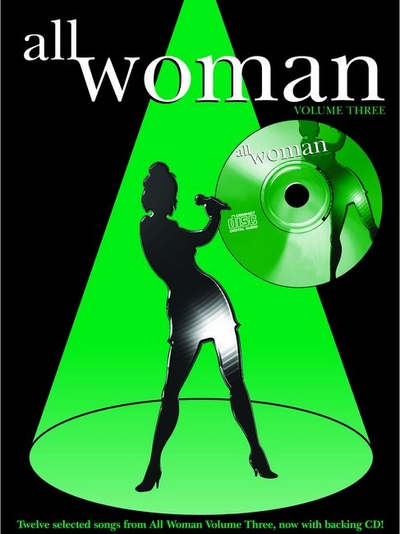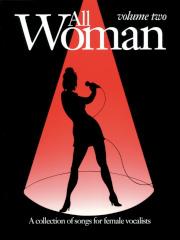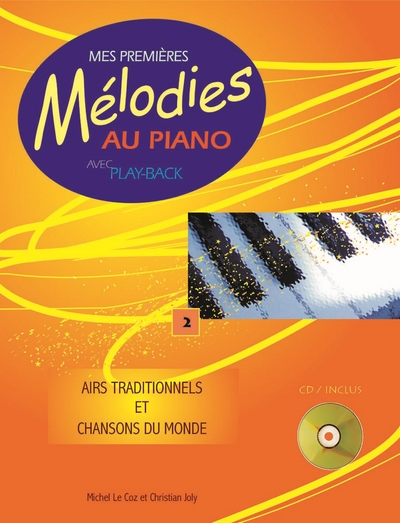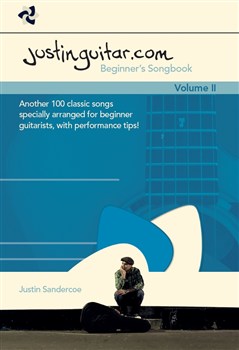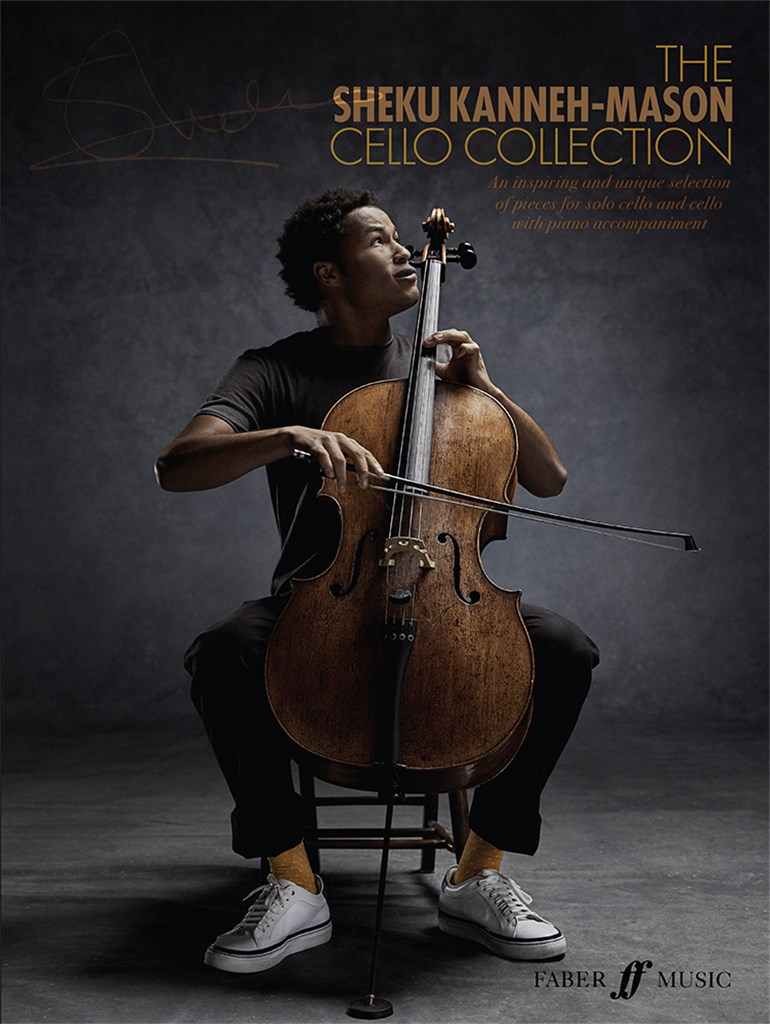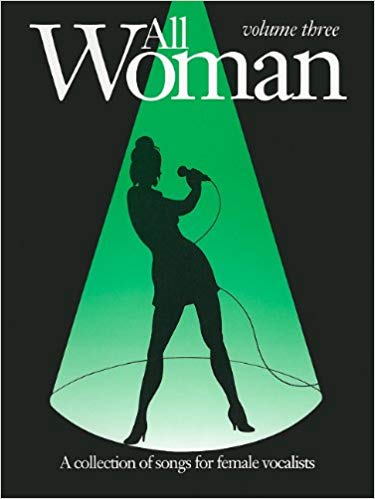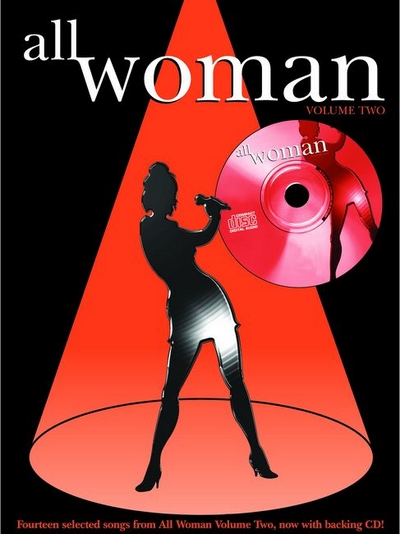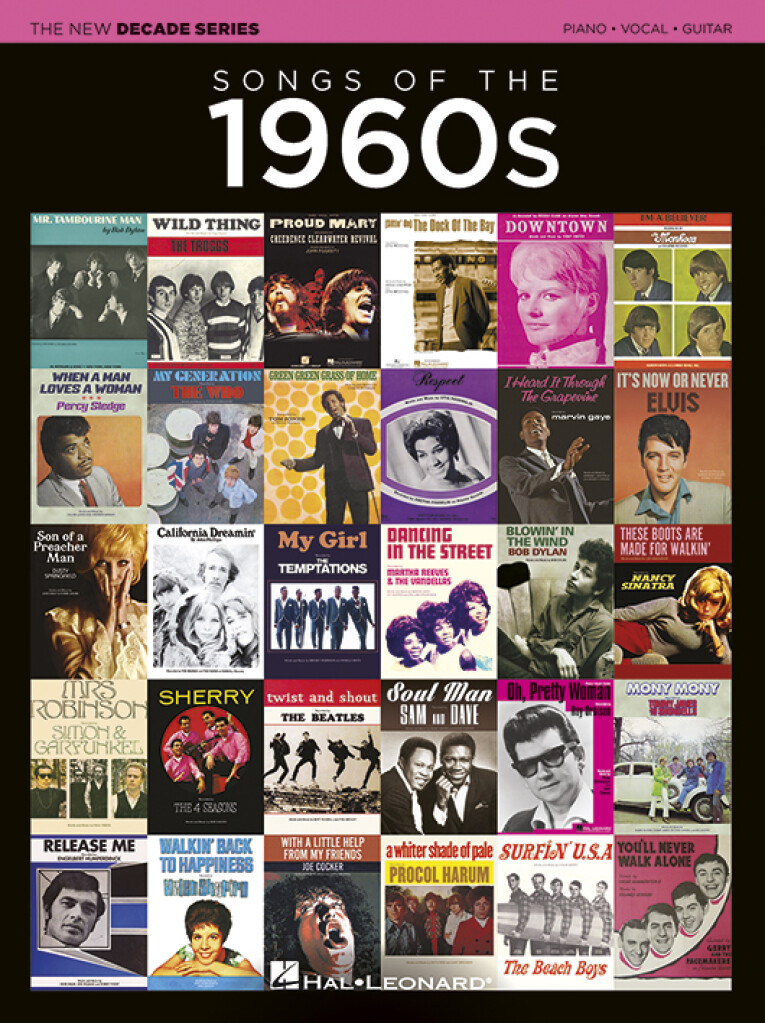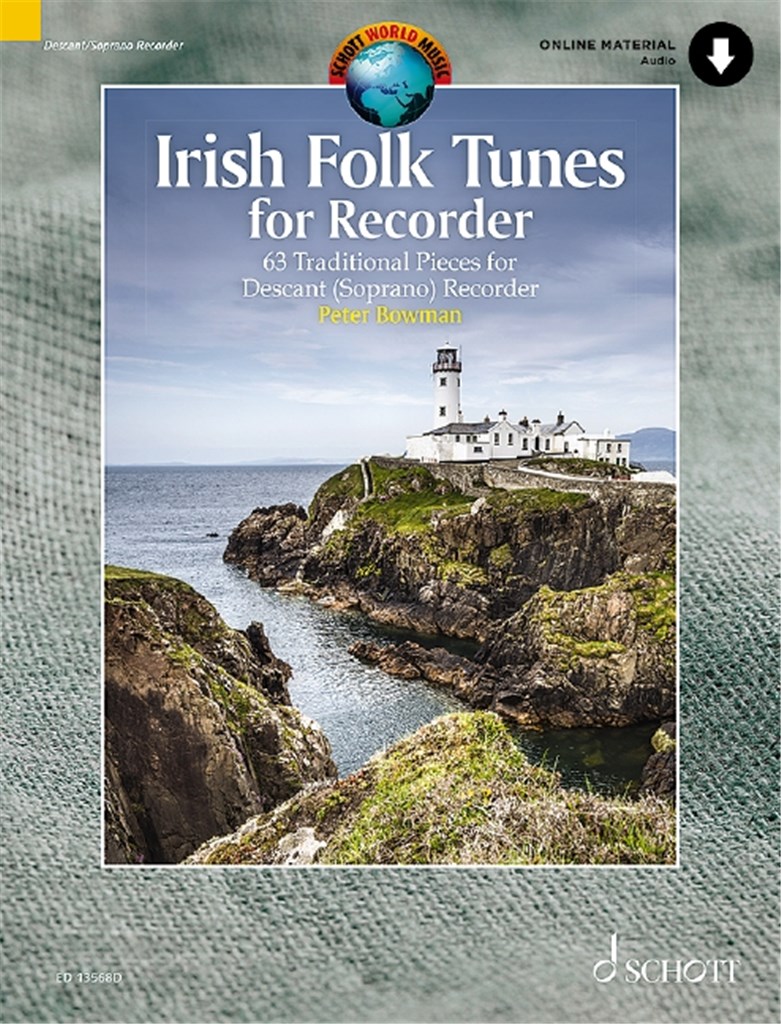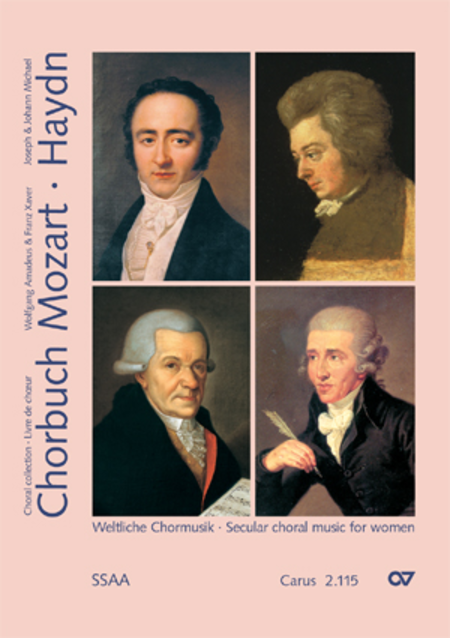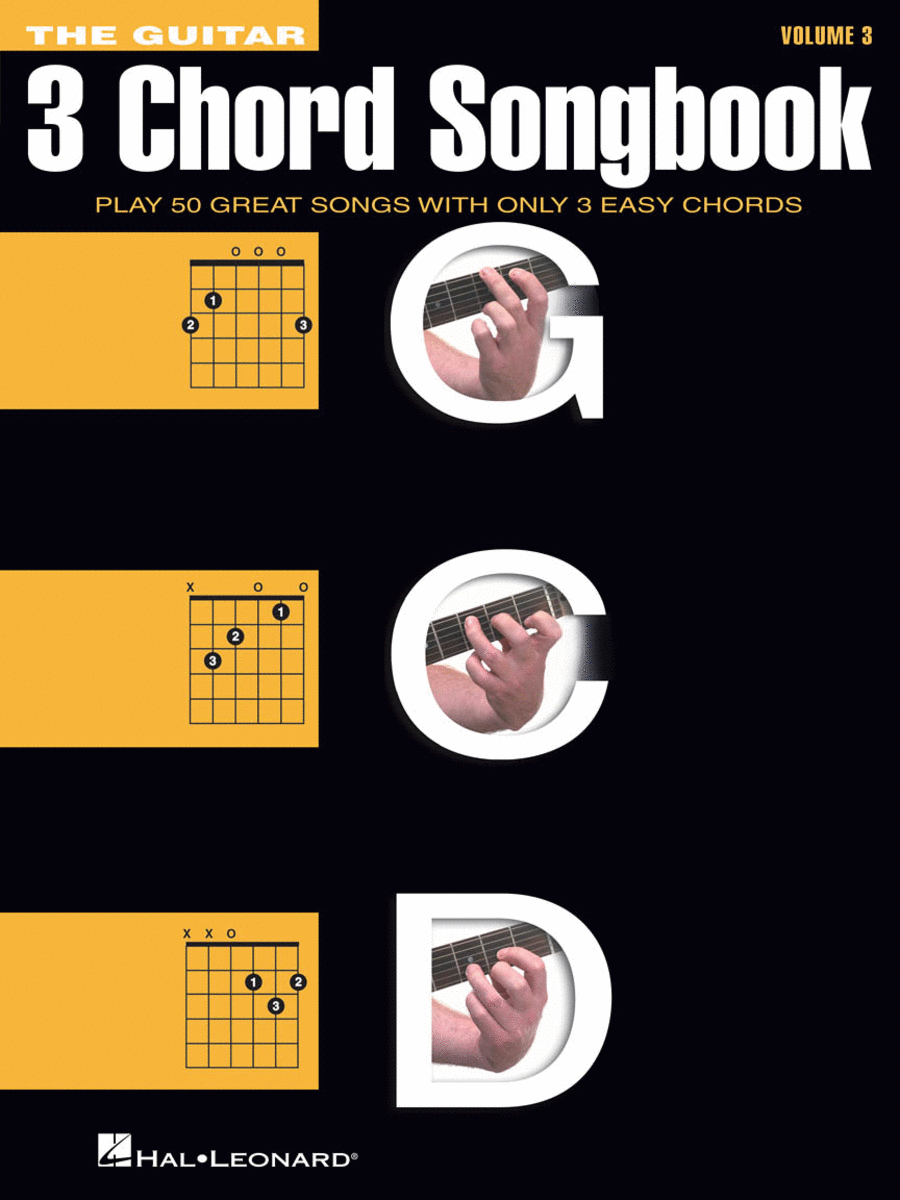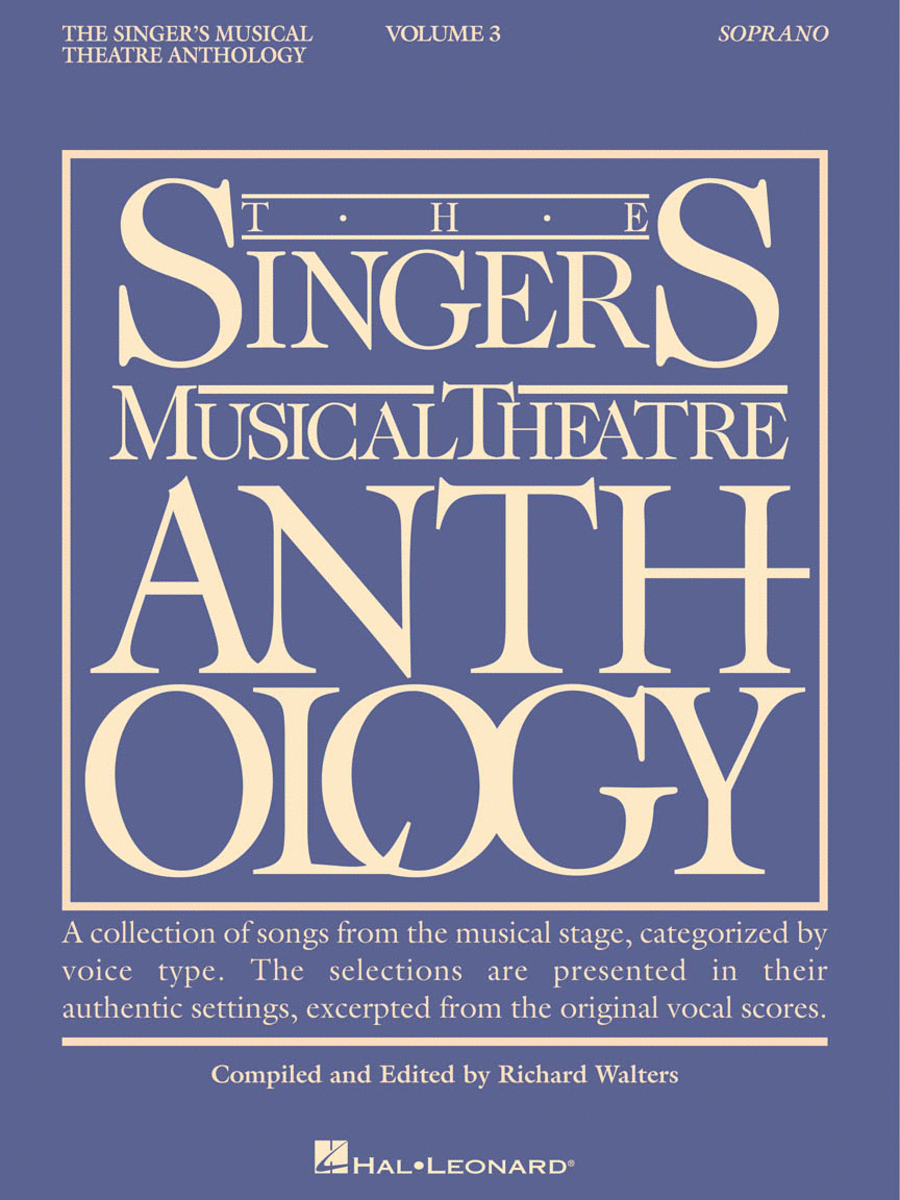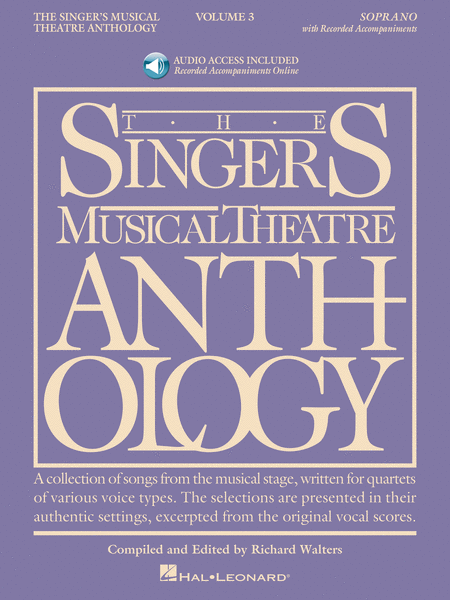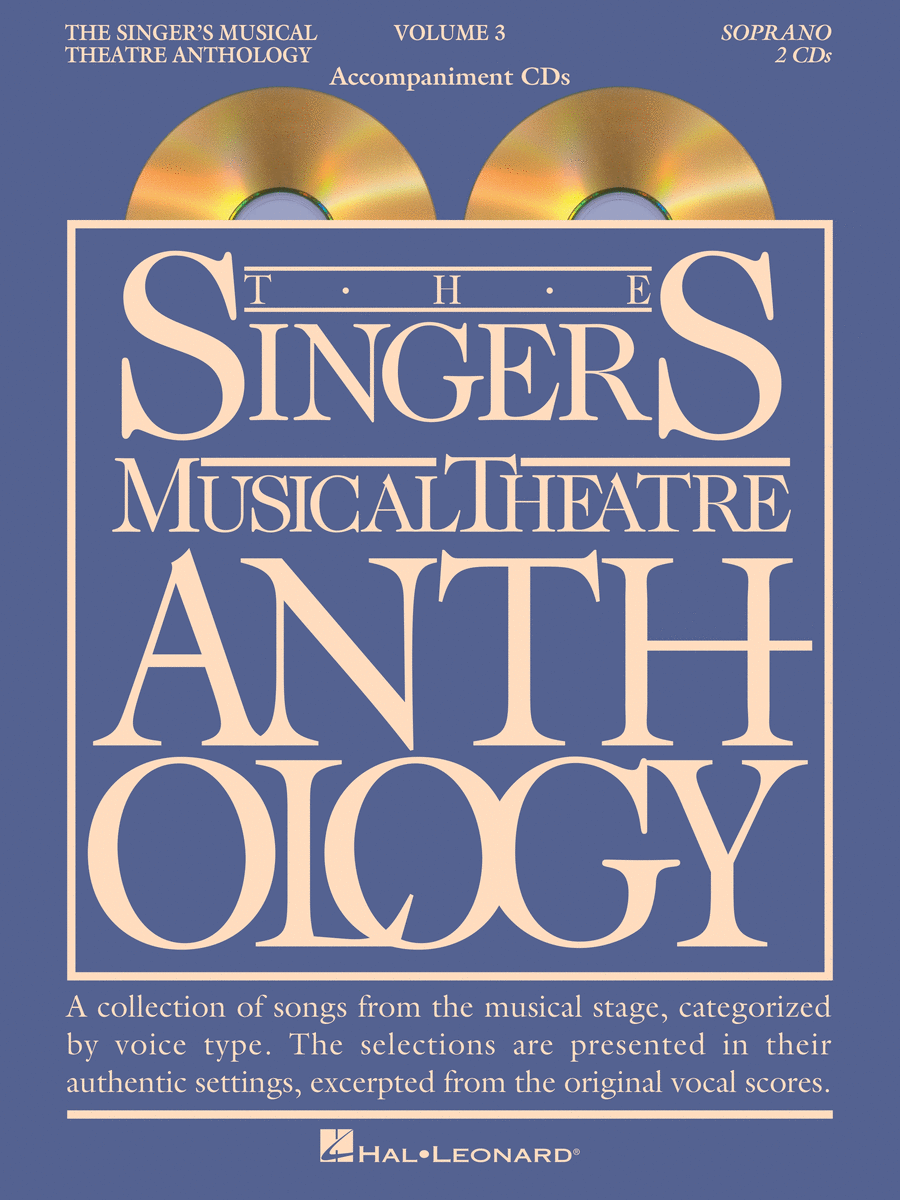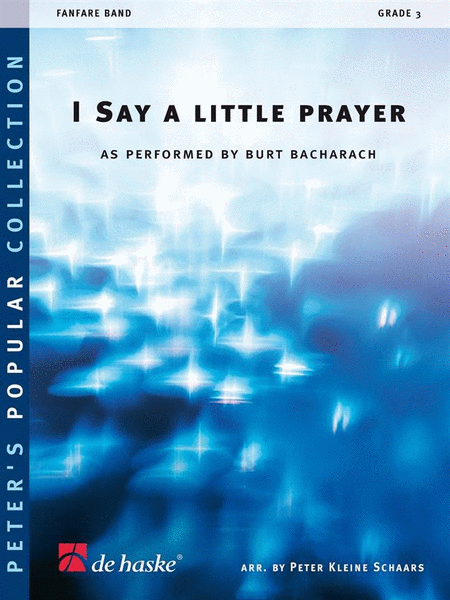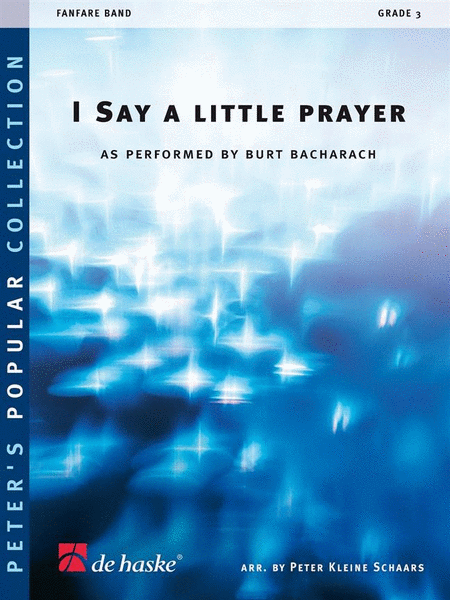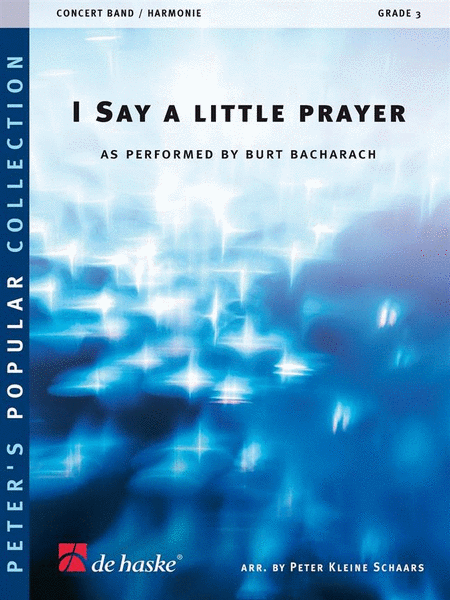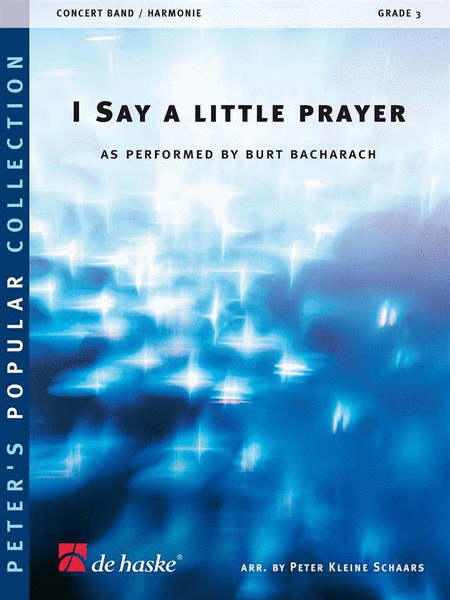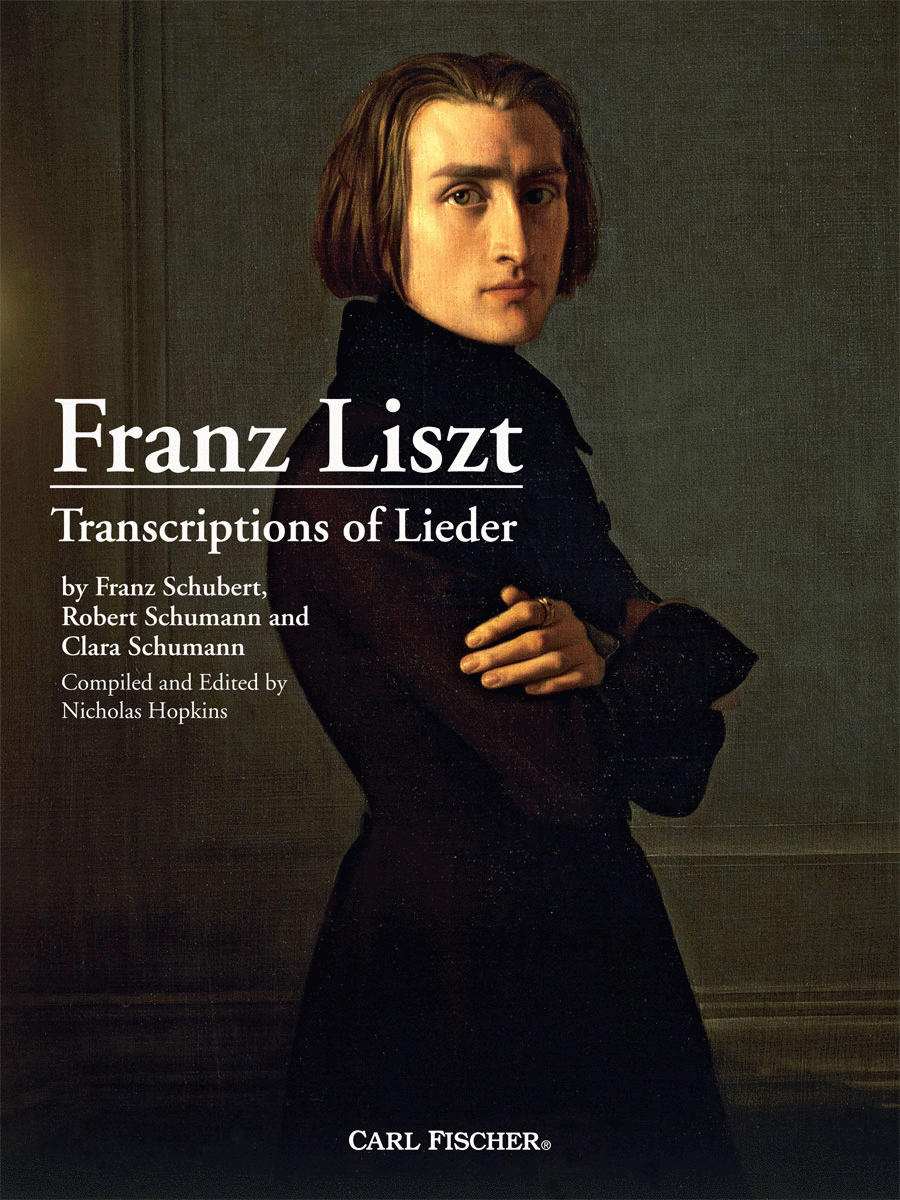|
| All Woman Collection.
Vol.2
Piano, Voix et Guitare [Partition]
I.M.P.
A four-part collection of songs for female vocalists, as sung by some of the gre...(+)
A four-part collection of songs for female vocalists, as sung by some of the great female artists of the last 50 years, arranged for piano and voice, complete with lyrics and guitar chord boxes. / Pop & rock / Recueil / Piano, Chant et Guitare
Délais: 2-5 jours - En Stock Fournisseur | | |
| Mes Premières
Mélodies Au Piano
Vol.2 : Musiques Et
Chansons Du Monde (LE COZ
MICHEL)
 En Français En Français
Piano seul [Partition + CD]
Hit Diffusion
Par LE COZ MICHEL. Répertoire pour piano destiné aux tout débutants, du piano...(+)
Par LE COZ MICHEL. Répertoire pour piano destiné aux tout débutants, du piano vraiment facile pour pouvoir jouer et prendre du plaisir dès les premières notes, seul ou accompagné de play-backs. Volume consacré aux airs et musiques traditionnelles du monde entier. Livre CD Autres volumes disponibles dans la collection : Volume 1, Volume 3. / Répertoire / Recueil / Piano
Délais: En Stock | | |
| Justinguitar.Com
Beginner's Songbook
Vol.2
Guitare [Partition]
Amsco Wise Publications
Following on from the first volume of his bestselling Beginner's Songbook, Volum...(+)
Following on from the first volume of his bestselling Beginner's Songbook, Volume 2 boasts another 100 classic songs from the past and present, specially arranged for beginner guitarists. Featuring complete lyrics and chords, as well as tuition notes, with invaluable advice on strumming, chords and general playing tips. The Justinguitar.com Beginner's Songbook Volume 2 is a great companion to Justin's beginner Guitar method, with ten songs for each stage of the course, progressing in difficulty. The songs range from the past to the present and represent a variety of genres, ranging from songs with only two or three chords like Bad Moon Rising, For What It's Worth and Stir It Up through to tunes like Get Lucky and Budapest, all the way to songs like Hold Back The River and Ziggy Stardust, with more complicated rhythms, chords and strumming. Every song features full lyrics and chords, strumming patterns as well as advice about tricky aspects of the song, or just general performance tips. If you need help with the chords, diagrams are included so that you always have a reference. As your playing develops through the course, the best way to practise is to play along to your favourite tunes, and the Justinguitar.com Beginner's Songbook Volume 2 is the best way to expand your repertoire at the level of your ability. Featuring 100 songs by artists like The Beatles, Ed Sheeran, Bob Marley, Maroon 5, Nirvana and The Rolling Stones, this songbook is a fantastic collection, an invaluable companion to the influential course, and a brilliant follow-up to volume 1, which has sold over 100,000 copies. / Guitare
Délais: 2-5 jours - En Stock Fournisseur | | |
| The Sheku Kanneh-Mason
Cello Collection
Violoncelle, Piano [Partition]
Faber Music Limited
The Sheku Kanneh-Mason Cello Collection combines the artist’s renowned perform...(+)
The Sheku Kanneh-Mason Cello Collection combines the artist’s renowned performance repertoire with his own inspirational compositions, all as performed by Sheku himself. Suitable for the intermediate cellist and beyond, this dynamic volume is sure to spark a desire to perform. With commentary from Sheku revealing the stories behind the pieces and his own expert advice, this collection is a must-have for all aspiring cellists./ Recueil / Violoncelle et Piano
Délais: 2-5 jours - En Stock Fournisseur | | |
| All Woman Collection.
Vol.3
Piano, Voix et Guitare [Partition + CD] - Facile
Faber Music Limited
12 classic songs from Madonna, Shirley Bassey, Celine Dion and many others. Inlc...(+)
12 classic songs from Madonna, Shirley Bassey, Celine Dion and many others. Inlcudes CD. / Niveau : Assez Facile / Recueil / Piano, Chant et Guitare
Délais: 2-5 jours - En Stock Fournisseur | | |
| All Woman Collection.
Vol.3
Piano, Voix et Guitare [Partition]
I.M.P.
Pop/Rock / Rép International / Recueil / Piano, Chant et Guitare
Délais: 2-5 jours - En Stock Fournisseur | | |
| All Woman Collection.
Vol.2
Piano, Voix et Guitare [Partition + CD] - Facile
Faber Music Limited
14 classic tunes including the fabulous 'Don't it make my brown eyes blue'. Pian...(+)
14 classic tunes including the fabulous 'Don't it make my brown eyes blue'. Piano score with guitar tab. / Niveau : Assez Facile / Recueil / Piano, Chant et Guitare
Délais: 2-5 jours - En Stock Fournisseur | | |
| The New Decade Series:
Songs of the 1960s
Piano, Voix et Guitare [Partition]
Hal Leonard
Par . La nouvelle collection The New Decade Series propose une compilation des m...(+)
Par . La nouvelle collection The New Decade Series propose une compilation des meilleurs tubes pop-rock par décennies musicales arrangés pour Piano, Voix et Guitare. Découvrez les 4 premiers volumes de cette collection contenant environs 80 morceaux chacun : - les années 90 des Spice Girls à Oasis - les années 80 de Madonna à David Bowie - les années 70 d'ABBA à Queen - les années 60 des Beatles à Jimi Hendrix / Date parution : 2022-10-25/ Recueil / Piano/Vocal/Guitare (PVG)
Délais: 2-5 jours - En Stock Fournisseur | | |
| Irish Folk Tunes For
Descant Recorder (BOWMAN
PETER)
Flûte à Bec - Facile
Schott
63 Traditional Pieces. Par BOWMAN PETER. Irish Folk Tunes for Descant Recorder i...(+)
63 Traditional Pieces. Par BOWMAN PETER. Irish Folk Tunes for Descant Recorder is a collection of 63 arrangements for descant recorder, of traditional tunes including a range of styles such as Reels, Hornpipes, Jigs and more.
Experienced recorder player and co-author of English Folk Tunes for Descant Recorder, the Baroque Recorder Anthology series, and Fun and Games with the Recorder series amongst others, Peter Bowman provides notes on all of the styles covered, as well as individual pieces. German and French translations of all texts are available as pdf downloads from the Schott Music website. Suitable for players of grades 3-8.
The volume contains recordings for download in order to get a sound impression of the stylistic and technical features of the pieces. / Niveau : Facile / Recueil / Flûte à Bec
Délais: En Stock | |
|
|
|
| Secular choral music for woman's choir
Chorale 3 parties
SSA
Carus Verlag
By Various. Edited by Armin Kircher. For SSA choir. Choral collections. Mozart/H...(+)
By Various. Edited by
Armin Kircher. For SSA
choir. Choral
collections. Mozart/Haydn
5. Chorbuch weltl. SSA)
Einzelex. Choral
collection. 48 pages.
Published by Carus Verlag
. Choral collection.
$20.95 - Voir plus => AcheterDélais: 2 to 3 weeks | | | |
| The Guitar Three-Chord Songbook - Volume 3 G-C-D
Paroles et Accords - Facile
Hal Leonard
(Melody/Lyrics/Chords). By Various. For Guitar. Guitar Collection. Softcover. 96...(+)
(Melody/Lyrics/Chords).
By Various. For Guitar.
Guitar Collection.
Softcover. 96 pages.
Published by Hal Leonard
$16.99 - Voir plus => AcheterDélais: 24 hours - In Stock | | | |
| The Singer's Musical Theatre Anthology - Volume 3
Voix Soprano, Piano [Partition]
Hal Leonard
Soprano and Piano. By Various. Arranged by Richard Walters. Vocal Collection. Si...(+)
Soprano and Piano. By
Various. Arranged by
Richard Walters. Vocal
Collection. Size 9x12
inches. 232 pages.
(1)$26.99 - Voir plus => AcheterDélais: 24 hours - In Stock | | | |
| Singer's Musical Theatre Anthology - Volume 3
Voix Soprano [Partition + Accès audio]
Hal Leonard
Composed by Various. Edited by Richard Walters. Vocal Collection. Piece for the ...(+)
Composed by Various.
Edited by Richard
Walters. Vocal
Collection. Piece for the
NFMC Vocal event with the
National Federation of
Music Clubs (NFMC)
Festivals Bulletin
2008-2009-2010. Broadway,
Instruction. Softcover
book and online audio.
232 pages. Published by
Hal Leonard
(1)$44.99 - Voir plus => AcheterDélais: 24 hours - In Stock | | | |
| The Singer's Musical Theatre Anthology - Volume 3 (CD)
Voix Soprano [CD d'accompagnement]
Hal Leonard
Soprano Accompaniment CDs. By Various Composers. (Soprano). Vocal Collection. CD...(+)
Soprano Accompaniment
CDs. By Various
Composers. (Soprano).
Vocal Collection. CD
only. Size 9x12 inches. 8
pages. Published by Hal
Leonard.
$26.99 - Voir plus => AcheterDélais: 24 hours - In Stock | | | |
| I Say A Little Prayer
Fanfare [Conducteur et Parties séparées] - Facile
De Haske Publications
Fanfare Band - Grade 3 SKU: BT.DHP-1206249-020 As performed by Burt Ba...(+)
Fanfare Band - Grade 3
SKU:
BT.DHP-1206249-020
As performed by Burt
Bacharach. Composed
by Burt Bacharach.
Arranged by Peter Kleine
Schaars. Peter's Popular
Collection. Pop & Rock.
Set (Score & Parts).
Composed 2020. De Haske
Publications #DHP
1206249-020. Published by
De Haske Publications
(BT.DHP-1206249-020).
This
bittersweet song from
1967 is a real classic,
partly due to the
rendition by two queens
of soul, Dionne Warwick
and later also Aretha
Franklin. The theme was
very topical at the time:
A woman is concerned
about her husband
fighting in the Vietnam
War, and thinks about him
during her day-to-day
worries. Top arranger
Peter Kleine Schaars
created a tasteful and
carefully orchestrated
version. His arrangement
stays true to the
original colour and feel
of the song, and, as a
grade 3 piece, is still
perfectly playable for
most bands.
Deze
bitterzoete song uit 1967
is een echte klassieker,
mede doordat het door
twee soulkoninginnen,
Dionne Warwick en later
ook Aretha Franklin, werd
vertolkt. De thematiek
was destijds erg actueel:
een vrouw maakt zich
tijdens haar dagelijkse
beslommeringen zorgen om
haar man, die in de
Vietnamoorlog vecht.
Toparrangeur Peter Kleine
Schaars maakte er een
smaakvolle en zorgvuldig
georkestreerde versie
van. Zijn arrangement
blijft trouw aan de
originele kleur en feel
van de song, en is in
graad 3 toch voor de
meeste harmonieorkesten
probleemloos
speelbaar.
Dieses
bittersüße Lied aus
dem Jahr 1967 ist ein
echter Klassiker, was
teilweise auf die
Interpretationen der
beiden Queens of
Soul“ Dionne
Warwick und später
auch Aretha Franklin
zurückzuführen ist.
Das Thema war zu der
damaligen Zeit sehr
aktuell: Eine Frau macht
sich Sorgen um ihren
Mann, der im Vietnamkrieg
kämpft und denkt
während ihrer
Alltagssorgen an ihn.
Top-Arrangeur Peter
Kleine Schaars schuf eine
stilvolle und
sorgfältig
orchestrierte Version.
Sein Arrangement im
Schwierigkeitsgrad 3 hat
die ursprüngliche
Klangfarbe und Stimmung
des Liedes beibehalten
und ist für die
meisten Blasorchester gut
spielbar.
Cette
chanson sentimentale de
1967 est un grand
classique, en partie gr
ce son interprétation
par deux reines de la
soul, Dionne Warwick et
Aretha Franklin.
l’époque, son
thème était
d’actualité :
une femme
s’inquiète pour
son mari parti faire la
guerre au Vietnam et
pense lui pendant ses t
ches quotidiennes. Le
grand arrangeur Peter
Kleine Schaars a
élaboré une version
raffinée et habilement
orchestrée de cette
chanson. Son arrangement
reproduit fidèlement
les couleurs et le
ressenti d’origine
et, en tant que pièce
de niveau 3, est
parfaitement accessible
la plupart des
orchestres. $110.95 - Voir plus => AcheterDélais: 2 to 3 weeks | | | |
| I Say A Little Prayer
Fanfare [Conducteur] - Facile
De Haske Publications
Fanfare Band - Grade 3 SKU: BT.DHP-1206249-120 As performed by Burt Ba...(+)
Fanfare Band - Grade 3
SKU:
BT.DHP-1206249-120
As performed by Burt
Bacharach. Composed
by Burt Bacharach.
Arranged by Peter Kleine
Schaars. Peter's Popular
Collection. Pop & Rock.
Score Only. Composed
2020. 14 pages. De Haske
Publications #DHP
1206249-120. Published by
De Haske Publications
(BT.DHP-1206249-120).
This
bittersweet song from
1967 is a real classic,
partly due to the
rendition by two queens
of soul, Dionne Warwick
and later also Aretha
Franklin. The theme was
very topical at the time:
A woman is concerned
about her husband
fighting in the Vietnam
War, and thinks about him
during her day-to-day
worries. Top arranger
Peter Kleine Schaars
created a tasteful and
carefully orchestrated
version. His arrangement
stays true to the
original colour and feel
of the song, and, as a
grade 3 piece, is still
perfectly playable for
most bands.
Deze
bitterzoete song uit 1967
is een echte klassieker,
mede doordat het door
twee soulkoninginnen,
Dionne Warwick en later
ook Aretha Franklin, werd
vertolkt. De thematiek
was destijds erg actueel:
een vrouw maakt zich
tijdens haar dagelijkse
beslommeringen zorgen om
haar man, die in de
Vietnamoorlog vecht.
Toparrangeur Peter Kleine
Schaars maakte er een
smaakvolle en zorgvuldig
georkestreerde versie
van. Zijn arrangement
blijft trouw aan de
originele kleur en feel
van de song, en is in
graad 3 toch voor de
meeste harmonieorkesten
probleemloos
speelbaar.
Dieses
bittersüße Lied aus
dem Jahr 1967 ist ein
echter Klassiker, was
teilweise auf die
Interpretationen der
beiden Queens of
Soul“ Dionne
Warwick und später
auch Aretha Franklin
zurückzuführen ist.
Das Thema war zu der
damaligen Zeit sehr
aktuell: Eine Frau macht
sich Sorgen um ihren
Mann, der im Vietnamkrieg
kämpft und denkt
während ihrer
Alltagssorgen an ihn.
Top-Arrangeur Peter
Kleine Schaars schuf eine
stilvolle und
sorgfältig
orchestrierte Version.
Sein Arrangement im
Schwierigkeitsgrad 3 hat
die ursprüngliche
Klangfarbe und Stimmung
des Liedes beibehalten
und ist für die
meisten Blasorchester gut
spielbar.
Cette
chanson sentimentale de
1967 est un grand
classique, en partie gr
ce son interprétation
par deux reines de la
soul, Dionne Warwick et
Aretha Franklin.
l’époque, son
thème était
d’actualité :
une femme
s’inquiète pour
son mari parti faire la
guerre au Vietnam et
pense lui pendant ses t
ches quotidiennes. Le
grand arrangeur Peter
Kleine Schaars a
élaboré une version
raffinée et habilement
orchestrée de cette
chanson. Son arrangement
reproduit fidèlement
les couleurs et le
ressenti d’origine
et, en tant que pièce
de niveau 3, est
parfaitement accessible
la plupart des
orchestres. $23.95 - Voir plus => AcheterDélais: 2 to 3 weeks | | | |
| I Say A Little Prayer
Orchestre d'harmonie [Conducteur et Parties séparées] - Facile
De Haske Publications
Concert Band/Harmonie - Grade 3 SKU: BT.DHP-1206249-010 As performed b...(+)
Concert Band/Harmonie -
Grade 3 SKU:
BT.DHP-1206249-010
As performed by Burt
Bacharach. Composed
by Burt Bacharach.
Arranged by Peter Kleine
Schaars. Peter's Popular
Collection. Pop & Rock.
Set (Score & Parts).
Composed 2020. De Haske
Publications #DHP
1206249-010. Published by
De Haske Publications
(BT.DHP-1206249-010).
This
bittersweet song from
1967 is a real classic,
partly due to the
rendition by two queens
of soul, Dionne Warwick
and later also Aretha
Franklin. The theme was
very topical at the time:
A woman is concerned
about her husband
fighting in the Vietnam
War, and thinks about him
during her day-to-day
worries. Top arranger
Peter Kleine Schaars
created a tasteful and
carefully orchestrated
version. His arrangement
stays true to the
original colour and feel
of the song, and, as a
grade 3 piece, is still
perfectly playable for
most bands.
Deze
bitterzoete song uit 1967
is een echte klassieker,
mede doordat het door
twee soulkoninginnen,
Dionne Warwick en later
ook Aretha Franklin, werd
vertolkt. De thematiek
was destijds erg actueel:
een vrouw maakt zich
tijdens haar dagelijkse
beslommeringen zorgen om
haar man, die in de
Vietnamoorlog vecht.
Toparrangeur Peter Kleine
Schaars maakte er een
smaakvolle en zorgvuldig
georkestreerde versie
van. Zijn arrangement
blijft trouw aan de
originele kleur en feel
van de song, en is in
graad 3 toch voor de
meeste harmonieorkesten
probleemloos
speelbaar.
Dieses
bittersüße Lied aus
dem Jahr 1967 ist ein
echter Klassiker, was
teilweise auf die
Interpretationen der
beiden Queens of
Soul“ Dionne
Warwick und später
auch Aretha Franklin
zurückzuführen ist.
Das Thema war zu der
damaligen Zeit sehr
aktuell: Eine Frau macht
sich Sorgen um ihren
Mann, der im Vietnamkrieg
kämpft und denkt
während ihrer
Alltagssorgen an ihn.
Top-Arrangeur Peter
Kleine Schaars schuf eine
stilvolle und
sorgfältig
orchestrierte Version.
Sein Arrangement im
Schwierigkeitsgrad 3 hat
die ursprüngliche
Klangfarbe und Stimmung
des Liedes beibehalten
und ist für die
meisten Blasorchester gut
spielbar.
Cette
chanson sentimentale de
1967 est un grand
classique, en partie gr
ce son interprétation
par deux reines de la
soul, Dionne Warwick et
Aretha Franklin.
l’époque, son
thème était
d’actualité :
une femme
s’inquiète pour
son mari parti faire la
guerre au Vietnam et
pense lui pendant ses t
ches quotidiennes. Le
grand arrangeur Peter
Kleine Schaars a
élaboré une version
raffinée et habilement
orchestrée de cette
chanson. Son arrangement
reproduit fidèlement
les couleurs et le
ressenti d’origine
et, en tant que pièce
de niveau 3, est
parfaitement accessible
la plupart des
orchestres. $110.95 - Voir plus => AcheterDélais: 2 to 3 weeks | | | |
| I Say A Little Prayer
Orchestre d'harmonie [Conducteur] - Facile
De Haske Publications
Concert Band/Harmonie - Grade 3 SKU: BT.DHP-1206249-140 As performed b...(+)
Concert Band/Harmonie -
Grade 3 SKU:
BT.DHP-1206249-140
As performed by Burt
Bacharach. Composed
by Burt Bacharach.
Arranged by Peter Kleine
Schaars. Peter's Popular
Collection. Pop & Rock.
Score Only. Composed
2020. 14 pages. De Haske
Publications #DHP
1206249-140. Published by
De Haske Publications
(BT.DHP-1206249-140).
This
bittersweet song from
1967 is a real classic,
partly due to the
rendition by two queens
of soul, Dionne Warwick
and later also Aretha
Franklin. The theme was
very topical at the time:
A woman is concerned
about her husband
fighting in the Vietnam
War, and thinks about him
during her day-to-day
worries. Top arranger
Peter Kleine Schaars
created a tasteful and
carefully orchestrated
version. His arrangement
stays true to the
original colour and feel
of the song, and, as a
grade 3 piece, is still
perfectly playable for
most bands.
Deze
bitterzoete song uit 1967
is een echte klassieker,
mede doordat het door
twee soulkoninginnen,
Dionne Warwick en later
ook Aretha Franklin, werd
vertolkt. De thematiek
was destijds erg actueel:
een vrouw maakt zich
tijdens haar dagelijkse
beslommeringen zorgen om
haar man, die in de
Vietnamoorlog vecht.
Toparrangeur Peter Kleine
Schaars maakte er een
smaakvolle en zorgvuldig
georkestreerde versie
van. Zijn arrangement
blijft trouw aan de
originele kleur en feel
van de song, en is in
graad 3 toch voor de
meeste harmonieorkesten
probleemloos
speelbaar.
Dieses
bittersüße Lied aus
dem Jahr 1967 ist ein
echter Klassiker, was
teilweise auf die
Interpretationen der
beiden Queens of
Soul“ Dionne
Warwick und später
auch Aretha Franklin
zurückzuführen ist.
Das Thema war zu der
damaligen Zeit sehr
aktuell: Eine Frau macht
sich Sorgen um ihren
Mann, der im Vietnamkrieg
kämpft und denkt
während ihrer
Alltagssorgen an ihn.
Top-Arrangeur Peter
Kleine Schaars schuf eine
stilvolle und
sorgfältig
orchestrierte Version.
Sein Arrangement im
Schwierigkeitsgrad 3 hat
die ursprüngliche
Klangfarbe und Stimmung
des Liedes beibehalten
und ist für die
meisten Blasorchester gut
spielbar.
Cette
chanson sentimentale de
1967 est un grand
classique, en partie gr
ce son interprétation
par deux reines de la
soul, Dionne Warwick et
Aretha Franklin.
l’époque, son
thème était
d’actualité :
une femme
s’inquiète pour
son mari parti faire la
guerre au Vietnam et
pense lui pendant ses t
ches quotidiennes. Le
grand arrangeur Peter
Kleine Schaars a
élaboré une version
raffinée et habilement
orchestrée de cette
chanson. Son arrangement
reproduit fidèlement
les couleurs et le
ressenti d’origine
et, en tant que pièce
de niveau 3, est
parfaitement accessible
la plupart des
orchestres. $23.95 - Voir plus => AcheterDélais: 2 to 3 weeks | | | |
| Transcriptions of Lieder
Piano seul
Carl Fischer
Chamber Music Piano SKU: CF.PL1056 Composed by Clara Wieck-Schumann, Fran...(+)
Chamber Music Piano
SKU: CF.PL1056
Composed by Clara
Wieck-Schumann, Franz
Schubert, and Robert
Schumann. Edited by
Nicholas Hopkins.
Collection. With Standard
notation. 128 pages. Carl
Fischer Music #PL1056.
Published by Carl Fischer
Music (CF.PL1056).
ISBN 9781491153390.
UPC: 680160910892.
Transcribed by Franz
Liszt. Introduction
It is true that Schubert
himself is somewhat to
blame for the very
unsatisfactory manner in
which his admirable piano
pieces are treated. He
was too immoderately
productive, wrote
incessantly, mixing
insignificant with
important things, grand
things with mediocre
work, paid no heed to
criticism, and always
soared on his wings. Like
a bird in the air, he
lived in music and sang
in angelic fashion.
--Franz Liszt, letter to
Dr. S. Lebert (1868) Of
those compositions that
greatly interest me,
there are only Chopin's
and yours. --Franz Liszt,
letter to Robert Schumann
(1838) She [Clara
Schumann] was astounded
at hearing me. Her
compositions are really
very remarkable,
especially for a woman.
There is a hundred times
more creativity and real
feeling in them than in
all the past and present
fantasias by Thalberg.
--Franz Liszt, letter to
Marie d'Agoult (1838)
Chretien Urhan
(1790-1845) was a
Belgian-born violinist,
organist and composer who
flourished in the musical
life of Paris in the
early nineteenth century.
According to various
accounts, he was deeply
religious, harshly
ascetic and wildly
eccentric, though revered
by many important and
influential members of
the Parisian musical
community. Regrettably,
history has forgotten
Urhan's many musical
achievements, the most
important of which was
arguably his pioneering
work in promoting the
music of Franz Schubert.
He devoted much of his
energies to championing
Schubert's music, which
at the time was unknown
outside of Vienna.
Undoubtedly, Urhan was
responsible for
stimulating this
enthusiasm in Franz
Liszt; Liszt regularly
heard Urhan's organ
playing in the
St.-Vincent-de-Paul
church in Paris, and the
two became personal
acquaintances. At
eighteen years of age,
Liszt was on the verge of
establishing himself as
the foremost pianist in
Europe, and this
awakening to Schubert's
music would prove to be a
profound experience.
Liszt's first travels
outside of his native
provincial Hungary were
to Vienna in 1821-1823,
where his father enrolled
him in studies with Carl
Czerny (piano) and
Antonio Salieri (music
theory). Both men had
important involvements
with Schubert; Czerny
(like Urhan) as performer
and advocate of
Schubert's music and
Salieri as his theory and
composition teacher from
1813-1817. Curiously,
Liszt and Schubert never
met personally, despite
their geographical
proximity in Vienna
during these years.
Inevitably, legends later
arose that the two had
been personal
acquaintances, although
Liszt would dismiss these
as fallacious: I never
knew Schubert personally,
he was once quoted as
saying. Liszt's initial
exposure to Schubert's
music was the Lieder,
what Urhan prized most of
all. He accompanied the
tenor Benedict
Randhartinger in numerous
performances of
Schubert's Lieder and
then, perhaps realizing
that he could benefit the
composer more on his own
terms, transcribed a
number of the Lieder for
piano solo. Many of these
transcriptions he would
perform himself on
concert tour during the
so-called Glanzzeit, or
time of splendor from
1839-1847. This publicity
did much to promote
reception of Schubert's
music throughout Europe.
Once Liszt retired from
the concert stage and
settled in Weimar as a
conductor in the 1840s,
he continued to perform
Schubert's orchestral
music, his Symphony No. 9
being a particular
favorite, and is credited
with giving the world
premiere performance of
Schubert's opera Alfonso
und Estrella in 1854. At
this time, he
contemplated writing a
biography of the
composer, which
regrettably remained
uncompleted. Liszt's
devotion to Schubert
would never waver.
Liszt's relationship with
Robert and Clara Schumann
was far different and far
more complicated; by
contrast, they were all
personal acquaintances.
What began as a
relationship of mutual
respect and admiration
soon deteriorated into
one of jealousy and
hostility, particularly
on the Schumann's part.
Liszt's initial contact
with Robert's music
happened long before they
had met personally, when
Liszt published an
analysis of Schumann's
piano music for the
Gazette musicale in 1837,
a gesture that earned
Robert's deep
appreciation. In the
following year Clara met
Liszt during a concert
tour in Vienna and
presented him with more
of Schumann's piano
music. Clara and her
father Friedrich Wieck,
who accompanied Clara on
her concert tours, were
quite taken by Liszt: We
have heard Liszt. He can
be compared to no other
player...he arouses
fright and astonishment.
His appearance at the
piano is indescribable.
He is an original...he is
absorbed by the piano.
Liszt, too, was impressed
with Clara--at first the
energy, intelligence and
accuracy of her piano
playing and later her
compositions--to the
extent that he dedicated
to her the 1838 version
of his Etudes d'execution
transcendante d'apres
Paganini. Liszt had a
closer personal
relationship with Clara
than with Robert until
the two men finally met
in 1840. Schumann was
astounded by Liszt's
piano playing. He wrote
to Clara that Liszt had
played like a god and had
inspired indescribable
furor of applause. His
review of Liszt even
included a heroic
personification with
Napoleon. In Leipzig,
Schumann was deeply
impressed with Liszt's
interpretations of his
Noveletten, Op. 21 and
Fantasy in C Major, Op.
17 (dedicated to Liszt),
enthusiastically
observing that, I feel as
if I had known you twenty
years. Yet a variety of
events followed that
diminished Liszt's glory
in the eyes of the
Schumanns. They became
critical of the cult-like
atmosphere that arose
around his recitals, or
Lisztomania as it came to
be called; conceivably,
this could be attributed
to professional jealousy.
Clara, in particular,
came to loathe Liszt,
noting in a letter to
Joseph Joachim, I despise
Liszt from the depths of
my soul. She recorded a
stunning diary entry a
day after Liszt's death,
in which she noted, He
was an eminent keyboard
virtuoso, but a dangerous
example for the
young...As a composer he
was terrible. By
contrast, Liszt did not
share in these negative
sentiments; no evidence
suggests that he had any
ill-regard for the
Schumanns. In Weimar, he
did much to promote
Schumann's music,
conducting performances
of his Scenes from Faust
and Manfred, during a
time in which few
orchestras expressed
interest, and premiered
his opera Genoveva. He
later arranged a benefit
concert for Clara
following Robert's death,
featuring Clara as
soloist in Robert's Piano
Concerto, an event that
must have been
exhilarating to witness.
Regardless, her opinion
of him would never
change, despite his
repeated gestures of
courtesy and respect.
Liszt's relationship with
Schubert was a spiritual
one, with music being the
one and only link between
the two men. That with
the Schumanns was
personal, with music
influenced by a hero
worship that would
aggravate the
relationship over time.
Nonetheless, Liszt would
remain devoted to and
enthusiastic for the
music and achievements of
these composers. He would
be a vital force in
disseminating their music
to a wider audience, as
he would be with many
other composers
throughout his career.
His primary means for
accomplishing this was
the piano transcription.
Liszt and the
Transcription
Transcription versus
Paraphrase Transcription
and paraphrase were
popular terms in
nineteenth-century music,
although certainly not
unique to this period.
Musicians understood that
there were clear
distinctions between
these two terms, but as
is often the case these
distinctions could be
blurred. Transcription,
literally writing over,
entails reworking or
adapting a piece of music
for a performance medium
different from that of
its original; arrangement
is a possible synonym.
Adapting is a key part of
this process, for the
success of a
transcription relies on
the transcriber's ability
to adapt the piece to the
different medium. As a
result, the pre-existing
material is generally
kept intact, recognizable
and intelligible; it is
strict, literal,
objective. Contextual
meaning is maintained in
the process, as are
elements of style and
form. Paraphrase, by
contrast, implies
restating something in a
different manner, as in a
rewording of a document
for reasons of clarity.
In nineteenth-century
music, paraphrasing
indicated elaborating a
piece for purposes of
expressive virtuosity,
often as a vehicle for
showmanship. Variation is
an important element, for
the source material may
be varied as much as the
paraphraser's imagination
will allow; its purpose
is metamorphosis.
Transcription is adapting
and arranging;
paraphrasing is
transforming and
reworking. Transcription
preserves the style of
the original; paraphrase
absorbs the original into
a different style.
Transcription highlights
the original composer;
paraphrase highlights the
paraphraser.
Approximately half of
Liszt's compositional
output falls under the
category of transcription
and paraphrase; it is
noteworthy that he never
used the term
arrangement. Much of his
early compositional
activities were
transcriptions and
paraphrases of works of
other composers, such as
the symphonies of
Beethoven and Berlioz,
vocal music by Schubert,
and operas by Donizetti
and Bellini. It is
conceivable that he
focused so intently on
work of this nature early
in his career as a means
to perfect his
compositional technique,
although transcription
and paraphrase continued
well after the technique
had been mastered; this
might explain why he
drastically revised and
rewrote many of his
original compositions
from the 1830s (such as
the Transcendental Etudes
and Paganini Etudes) in
the 1850s. Charles Rosen,
a sympathetic interpreter
of Liszt's piano works,
observes, The new
revisions of the
Transcendental Etudes are
not revisions but concert
paraphrases of the old,
and their art lies in the
technique of
transformation. The
Paganini etudes are piano
transcriptions of violin
etudes, and the
Transcendental Etudes are
piano transcriptions of
piano etudes. The
principles are the same.
He concludes by noting,
Paraphrase has shaded off
into
composition...Composition
and paraphrase were not
identical for him, but
they were so closely
interwoven that
separation is impossible.
The significance of
transcription and
paraphrase for Liszt the
composer cannot be
overstated, and the
mutual influence of each
needs to be better
understood. Undoubtedly,
Liszt the composer as we
know him today would be
far different had he not
devoted so much of his
career to transcribing
and paraphrasing the
music of others. He was
perhaps one of the first
composers to contend that
transcription and
paraphrase could be
genuine art forms on
equal par with original
pieces; he even claimed
to be the first to use
these two terms to
describe these classes of
arrangements. Despite the
success that Liszt
achieved with this type
of work, others viewed it
with circumspection and
criticism. Robert
Schumann, although deeply
impressed with Liszt's
keyboard virtuosity, was
harsh in his criticisms
of the transcriptions.
Schumann interpreted them
as indicators that
Liszt's virtuosity had
hindered his
compositional development
and suggested that Liszt
transcribed the music of
others to compensate for
his own compositional
deficiencies.
Nonetheless, Liszt's
piano transcriptions,
what he sometimes called
partitions de piano (or
piano scores), were
instrumental in promoting
composers whose music was
unknown at the time or
inaccessible in areas
outside of major European
capitals, areas that
Liszt willingly toured
during his Glanzzeit. To
this end, the
transcriptions had to be
literal arrangements for
the piano; a Beethoven
symphony could not be
introduced to an
unknowing audience if its
music had been subjected
to imaginative
elaborations and
variations. The same
would be true of the 1833
transcription of
Berlioz's Symphonie
fantastique (composed
only three years
earlier), the
astonishingly novel
content of which would
necessitate a literal and
intelligible rendering.
Opera, usually more
popular and accessible
for the general public,
was a different matter,
and in this realm Liszt
could paraphrase the
original and manipulate
it as his imagination
would allow without
jeopardizing its
reception; hence, the
paraphrases on the operas
of Bellini, Donizetti,
Mozart, Meyerbeer and
Verdi. Reminiscence was
another term coined by
Liszt for the opera
paraphrases, as if the
composer were reminiscing
at the keyboard following
a memorable evening at
the opera. Illustration
(reserved on two
occasions for Meyerbeer)
and fantasy were
additional terms. The
operas of Wagner were
exceptions. His music was
less suited to paraphrase
due to its general lack
of familiarity at the
time. Transcription of
Wagner's music was thus
obligatory, as it was of
Beethoven's and Berlioz's
music; perhaps the
composer himself insisted
on this approach. Liszt's
Lieder Transcriptions
Liszt's initial
encounters with
Schubert's music, as
mentioned previously,
were with the Lieder. His
first transcription of a
Schubert Lied was Die
Rose in 1833, followed by
Lob der Tranen in 1837.
Thirty-nine additional
transcriptions appeared
at a rapid pace over the
following three years,
and in 1846, the Schubert
Lieder transcriptions
would conclude, by which
point he had completed
fifty-eight, the most of
any composer. Critical
response to these
transcriptions was highly
favorable--aside from the
view held by
Schumann--particularly
when Liszt himself played
these pieces in concert.
Some were published
immediately by Anton
Diabelli, famous for the
theme that inspired
Beethoven's variations.
Others were published by
the Viennese publisher
Tobias Haslinger (one of
Beethoven's and
Schubert's publishers in
the 1820s), who sold his
reserves so quickly that
he would repeatedly plead
for more. However,
Liszt's enthusiasm for
work of this nature soon
became exhausted, as he
noted in a letter of 1839
to the publisher
Breitkopf und Hartel:
That good Haslinger
overwhelms me with
Schubert. I have just
sent him twenty-four new
songs (Schwanengesang and
Winterreise), and for the
moment I am rather tired
of this work. Haslinger
was justified in his
demands, for the Schubert
transcriptions were
received with great
enthusiasm. One Gottfried
Wilhelm Fink, then editor
of the Allgemeine
musikalische Zeitung,
observed of these
transcriptions: Nothing
in recent memory has
caused such sensation and
enjoyment in both
pianists and audiences as
these arrangements...The
demand for them has in no
way been satisfied; and
it will not be until
these arrangements are
seen on pianos
everywhere. They have
indeed made quite a
splash. Eduard Hanslick,
never a sympathetic
critic of Liszt's music,
acknowledged thirty years
after the fact that,
Liszt's transcriptions of
Schubert Lieder were
epoch-making. There was
hardly a concert in which
Liszt did not have to
play one or two of
them--even when they were
not listed on the
program. These
transcriptions quickly
became some of his most
sough-after pieces,
despite their extreme
technical demands.
Leading pianists of the
day, such as Clara Wieck
and Sigismond Thalberg,
incorporated them into
their concert programs
immediately upon
publication. Moreover,
the transcriptions would
serve as inspirations for
other composers, such as
Stephen Heller, Cesar
Franck and later Leopold
Godowsky, all of whom
produced their own
transcriptions of
Schubert's Lieder. Liszt
would transcribe the
Lieder of other composers
as well, including those
by Mendelssohn, Chopin,
Anton Rubinstein and even
himself. Robert Schumann,
of course, would not be
ignored. The first
transcription of a
Schumann Lied was the
celebrated Widmung from
Myrten in 1848, the only
Schumann transcription
that Liszt completed
during the composer's
lifetime. (Regrettably,
there is no evidence of
Schumann's regard of this
transcription, or even if
he was aware of it.) From
the years 1848-1881,
Liszt transcribed twelve
of Robert Schumann's
Lieder (including one
orchestral Lied) and
three of Clara (one from
each of her three
published Lieder cycles);
he would transcribe no
other works of these two
composers. The Schumann
Lieder transcriptions,
contrary to those of
Schubert, are literal
arrangements, posing, in
general, far fewer
demands on the pianist's
technique. They are
comparatively less
imaginative in their
treatment of the original
material. Additionally,
they seem to have been
less valued in their day
than the Schubert
transcriptions, and it is
noteworthy that none of
the Schumann
transcriptions bear
dedications, as most of
the Schubert
transcriptions do. The
greatest challenge posed
by Lieder transcriptions,
regardless of the
composer or the nature of
the transcription, was to
combine the vocal and
piano parts of the
original such that the
character of each would
be preserved, a challenge
unique to this form of
transcription. Each part
had to be intact and
aurally recognizable, the
vocal line in particular.
Complications could be
manifold in a Lied that
featured dissimilar
parts, such as Schubert's
Auf dem Wasser zu singen,
whose piano accompaniment
depicts the rocking of
the boat on the
shimmering waves while
the vocal line reflects
on the passing of time.
Similar complications
would be encountered in
Gretchen am Spinnrade, in
which the ubiquitous
sixteenth-note pattern in
the piano's right hand
epitomizes the
ever-turning spinning
wheel over which the
soprano voice expresses
feelings of longing and
heartache. The resulting
transcriptions for solo
piano would place
exceptional demands on
the pianist. The
complications would be
far less imposing in
instances in which voice
and piano were less
differentiated, as in
many of Schumann's Lieder
that Liszt transcribed.
The piano parts in these
Lieder are true
accompaniments for the
voice, providing harmonic
foundation and rhythmic
support by doubling the
vocal line throughout.
The transcriptions, thus,
are strict and literal,
with far fewer demands on
both pianist and
transcriber. In all of
Liszt's Lieder
transcriptions,
regardless of the way in
which the two parts are
combined, the melody
(i.e. the vocal line) is
invariably the focal
point; the melody should
sing on the piano, as if
it were the voice. The
piano part, although
integral to contributing
to the character of the
music, is designed to
function as
accompaniment. A singing
melody was a crucial
objective in
nineteenth-century piano
performance, which in
part might explain the
zeal in transcribing and
paraphrasing vocal music
for the piano. Friedrich
Wieck, father and teacher
of Clara Schumann,
stressed this point
repeatedly in his 1853
treatise Clavier und
Gesang (Piano and Song):
When I speak in general
of singing, I refer to
that species of singing
which is a form of
beauty, and which is a
foundation for the most
refined and most perfect
interpretation of music;
and, above all things, I
consider the culture of
beautiful tones the basis
for the finest possible
touch on the piano. In
many respects, the piano
and singing should
explain and supplement
each other. They should
mutually assist in
expressing the sublime
and the noble, in forms
of unclouded beauty. Much
of Liszt's piano music
should be interpreted
with this concept in
mind, the Lieder
transcriptions and opera
paraphrases, in
particular. To this end,
Liszt provided numerous
written instructions to
the performer to
emphasize the vocal line
in performance, with
Italian directives such
as un poco marcato il
canto, accentuato assai
il canto and ben
pronunziato il canto.
Repeated indications of
cantando,singend and
espressivo il canto
stress the significance
of the singing tone. As
an additional means of
achieving this and
providing the performer
with access to the
poetry, Liszt insisted,
at what must have been a
publishing novelty at the
time, on printing the
words of the Lied in the
music itself. Haslinger,
seemingly oblivious to
Liszt's intent, initially
printed the poems of the
early Schubert
transcriptions separately
inside the front covers.
Liszt argued that the
transcriptions must be
reprinted with the words
underlying the notes,
exactly as Schubert had
done, a request that was
honored by printing the
words above the
right-hand staff. Liszt
also incorporated a
visual scheme for
distinguishing voice and
accompaniment, influenced
perhaps by Chopin, by
notating the
accompaniment in cue
size. His transcription
of Robert Schumann's
Fruhlings Ankunft
features the vocal line
in normal size, the piano
accompaniment in reduced
size, an unmistakable
guide in a busy texture
as to which part should
be emphasized: Example 1.
Schumann-Liszt Fruhlings
Ankunft, mm. 1-2. The
same practice may be
found in the
transcription of
Schumann's An die Turen
will ich schleichen. In
this piece, the performer
must read three staves,
in which the baritone
line in the central staff
is to be shared between
the two hands based on
the stem direction of the
notes: Example 2.
Schumann-Liszt An die
Turen will ich
schleichen, mm. 1-5. This
notational practice is
extremely beneficial in
this instance, given the
challenge of reading
three staves and the
manner in which the vocal
line is performed by the
two hands. Curiously,
Liszt did not use this
practice in other
transcriptions.
Approaches in Lieder
Transcription Liszt
adopted a variety of
approaches in his Lieder
transcriptions, based on
the nature of the source
material, the ways in
which the vocal and piano
parts could be combined
and the ways in which the
vocal part could sing.
One approach, common with
strophic Lieder, in which
the vocal line would be
identical in each verse,
was to vary the register
of the vocal part. The
transcription of Lob der
Tranen, for example,
incorporates three of the
four verses of the
original Lied, with the
register of the vocal
line ascending one octave
with each verse (from low
to high), as if three
different voices were
participating. By the
conclusion, the music
encompasses the entire
range of Liszt's keyboard
to produce a stunning
climactic effect, and the
variety of register of
the vocal line provides a
welcome textural variety
in the absence of the
words. The three verses
of the transcription of
Auf dem Wasser zu singen
follow the same approach,
in which the vocal line
ascends from the tenor,
to the alto and to the
soprano registers with
each verse.
Fruhlingsglaube adopts
the opposite approach, in
which the vocal line
descends from soprano in
verse 1 to tenor in verse
2, with the second part
of verse 2 again resuming
the soprano register;
this is also the case in
Das Wandern from
Mullerlieder. Gretchen am
Spinnrade posed a unique
problem. Since the poem's
narrator is female, and
the poem represents an
expression of her longing
for her lover Faust,
variation of the vocal
line's register, strictly
speaking, would have been
impractical. For this
reason, the vocal line
remains in its original
register throughout,
relentlessly colliding
with the sixteenth-note
pattern of the
accompaniment. One
exception may be found in
the fifth and final verse
in mm. 93-112, at which
point the vocal line is
notated in a higher
register and doubled in
octaves. This sudden
textural change, one that
is readily audible, was a
strategic means to
underscore Gretchen's
mounting anxiety (My
bosom urges itself toward
him. Ah, might I grasp
and hold him! And kiss
him as I would wish, at
his kisses I should
die!). The transcription,
thus, becomes a vehicle
for maximizing the
emotional content of the
poem, an exceptional
undertaking with the
general intent of a
transcription. Registral
variation of the vocal
part also plays a crucial
role in the transcription
of Erlkonig. Goethe's
poem depicts the death of
a child who is
apprehended by a
supernatural Erlking, and
Schubert, recognizing the
dramatic nature of the
poem, carefully depicted
the characters (father,
son and Erlking) through
unique vocal writing and
accompaniment patterns:
the Lied is a dramatic
entity. Liszt, in turn,
followed Schubert's
characterization in this
literal transcription,
yet took it an additional
step by placing the
register of the father's
vocal line in the
baritone range, that of
the son in the soprano
range and that of the
Erlking in the highest
register, options that
would not have been
available in the version
for voice and piano.
Additionally, Liszt
labeled each appearance
of each character in the
score, a means for
guiding the performer in
interpreting the dramatic
qualities of the Lied. As
a result, the drama and
energy of the poem are
enhanced in this
transcription; as with
Gretchen am Spinnrade,
the transcriber has
maximized the content of
the original. Elaboration
may be found in certain
Lieder transcriptions
that expand the
performance to a level of
virtuosity not found in
the original; in such
cases, the transcription
approximates the
paraphrase. Schubert's Du
bist die Ruh, a paradigm
of musical simplicity,
features an uncomplicated
piano accompaniment that
is virtually identical in
each verse. In Liszt's
transcription, the
material is subjected to
a highly virtuosic
treatment that far
exceeds the original,
including a demanding
passage for the left hand
alone in the opening
measures and unique
textural writing in each
verse. The piece is a
transcription in
virtuosity; its art, as
Rosen noted, lies in the
technique of
transformation.
Elaboration may entail an
expansion of the musical
form, as in the extensive
introduction to Die
Forelle and a virtuosic
middle section (mm.
63-85), both of which are
not in the original. Also
unique to this
transcription are two
cadenzas that Liszt
composed in response to
the poetic content. The
first, in m. 93 on the
words und eh ich es
gedacht (and before I
could guess it), features
a twisted chromatic
passage that prolongs and
thereby heightens the
listener's suspense as to
the fate of the trout
(which is ultimately
caught). The second, in
m. 108 on the words
Betrogne an (and my blood
boiled as I saw the
betrayed one), features a
rush of
diminished-seventh
arpeggios in both hands,
epitomizing the poet's
rage at the fisherman for
catching the trout. Less
frequent are instances in
which the length of the
original Lied was
shortened in the
transcription, a tendency
that may be found with
certain strophic Lieder
(e.g., Der Leiermann,
Wasserflut and Das
Wandern). Another
transcription that
demonstrates Liszt's
readiness to modify the
original in the interests
of the poetic content is
Standchen, the seventh
transcription from
Schubert's
Schwanengesang. Adapted
from Act II of
Shakespeare's Cymbeline,
the poem represents the
repeated beckoning of a
man to his lover. Liszt
transformed the Lied into
a miniature drama by
transcribing the vocal
line of the first verse
in the soprano register,
that of the second verse
in the baritone register,
in effect, creating a
dialogue between the two
lovers. In mm. 71-102,
the dialogue becomes a
canon, with one voice
trailing the other like
an echo (as labeled in
the score) at the
distance of a beat. As in
other instances, the
transcription resembles
the paraphrase, and it is
perhaps for this reason
that Liszt provided an
ossia version that is
more in the nature of a
literal transcription.
The ossia version, six
measures shorter than
Schubert's original, is
less demanding
technically than the
original transcription,
thus representing an
ossia of transcription
and an ossia of piano
technique. The Schumann
Lieder transcriptions, in
general, display a less
imaginative treatment of
the source material.
Elaborations are less
frequently encountered,
and virtuosity is more
restricted, as if the
passage of time had
somewhat tamed the
composer's approach to
transcriptions;
alternatively, Liszt was
eager to distance himself
from the fierce
virtuosity of his early
years. In most instances,
these transcriptions are
literal arrangements of
the source material, with
the vocal line in its
original form combined
with the accompaniment,
which often doubles the
vocal line in the
original Lied. Widmung,
the first of the Schumann
transcriptions, is one
exception in the way it
recalls the virtuosity of
the Schubert
transcriptions of the
1830s. Particularly
striking is the closing
section (mm. 58-73), in
which material of the
opening verse (right
hand) is combined with
the triplet quarter notes
(left hand) from the
second section of the
Lied (mm. 32-43), as if
the transcriber were
attempting to reconcile
the different material of
these two sections.
Fruhlingsnacht resembles
a paraphrase by
presenting each of the
two verses in differing
registers (alto for verse
1, mm. 3-19, and soprano
for verse 2, mm. 20-31)
and by concluding with a
virtuosic section that
considerably extends the
length of the original
Lied. The original
tonalities of the Lieder
were generally retained
in the transcriptions,
showing that the tonality
was an important part of
the transcription
process. The infrequent
instances of
transposition were done
for specific reasons. In
1861, Liszt transcribed
two of Schumann's Lieder,
one from Op. 36 (An den
Sonnenschein), another
from Op. 27 (Dem roten
Roslein), and merged
these two pieces in the
collection 2 Lieder; they
share only the common
tonality of A major. His
choice for combining
these two Lieder remains
unknown, but he clearly
recognized that some
tonal variety would be
needed, for which reason
Dem roten Roslein was
transposed to C>= major.
The collection features
An den Sonnenschein in A
major (with a transition
to the new tonality),
followed by Dem roten
Roslein in C>= major
(without a change of key
signature), and
concluding with a reprise
of An den Sonnenschein in
A major. A three-part
form was thus established
with tonal variety
provided by keys in third
relations (A-C>=-A); in
effect, two of Schumann's
Lieder were transcribed
into an archetypal song
without words. In other
instances, Liszt treated
tonality and tonal
organization as important
structural ingredients,
particularly in the
transcriptions of
Schubert's Lieder cycles,
i.e. Schwanengesang,
Winterreise a... $32.99 - Voir plus => AcheterDélais: 1 to 2 weeks | | |
|
|

